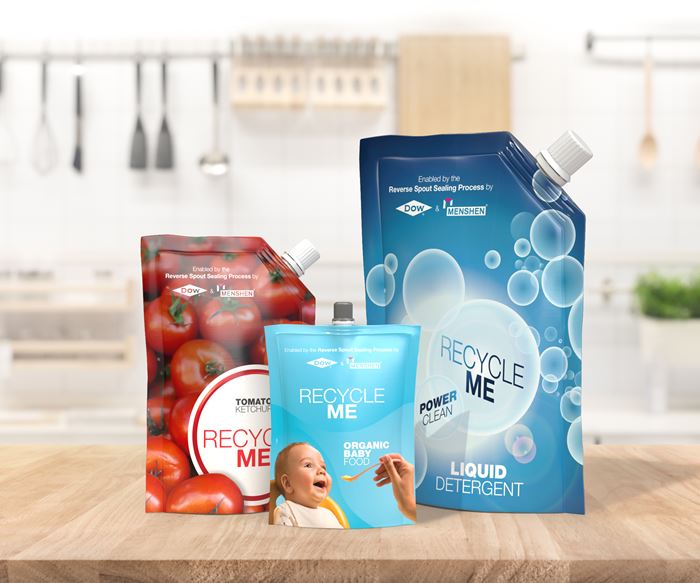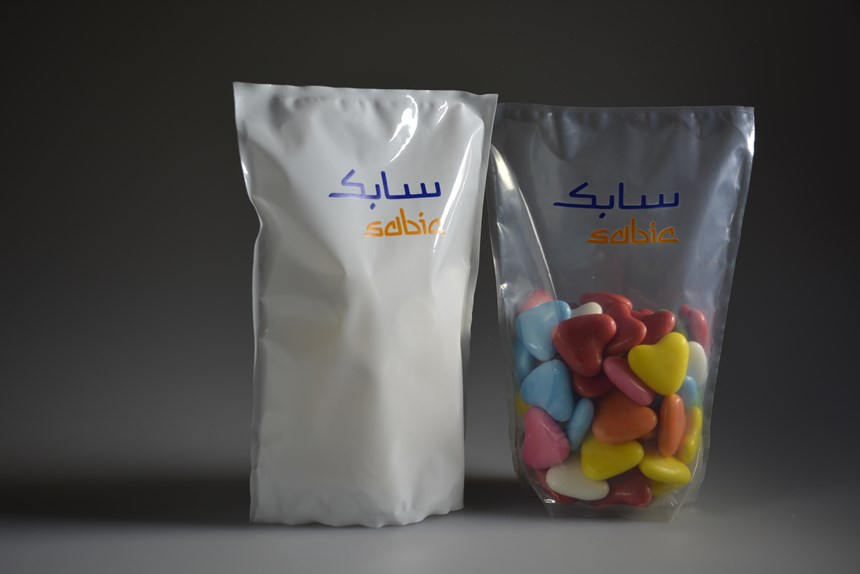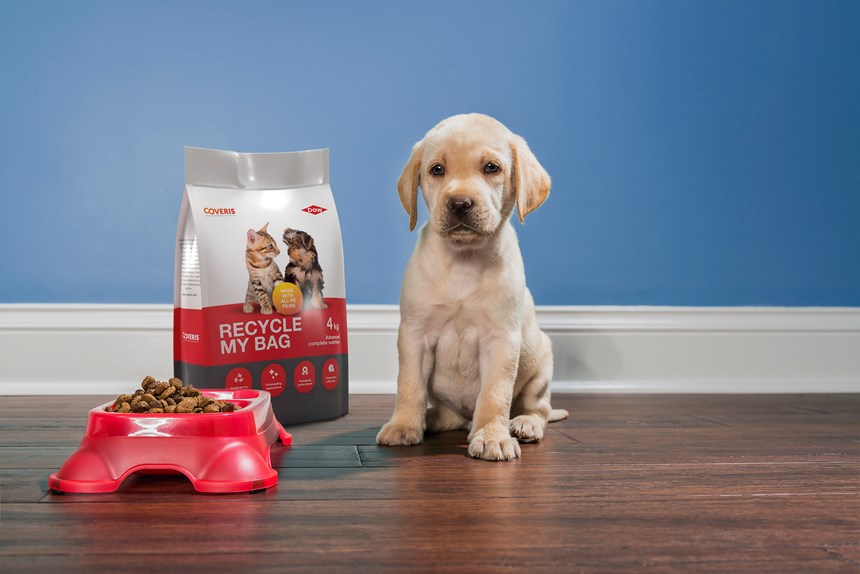Plastic film-based pouches are fast evolving in both variety of design and breadth of applications in packaging of dry and frozen foods, liquid foods, pet foods and non-food household products. Due to growing demand for sustainable packaging options from consumers and brand owners, all-PE structures have already gained a lead simply because of their potential recyclability advantage over multilayer, multi-material film structures. What’s more, manufacture of plastic pouches boasts 70% lower emissions than production of aluminum containers; and the pouches take up far less space than rigid containers, are very damage resistant, and lightweight and cheaper and more energy-efficient to transport.
A handful of leading polyolefin suppliers have made significant commercial strides in all-PE pouches within the last half-decade, and their specialty, high-performance PE polymers, including metallocene-catalyzed LLDPE (mLLDPE), allow processors to further downgauge films. There are also advances in HDPE, polyolefin elastomers and plastomers, and specialty coatings that allow replacement of film structures that contain PET or nylon for barrier properties and increased stiffness. Pioneers Dow, ExxonMobil and Nova Chemicals, with SABIC a more recent contender, highlighted their advances in such sustainable packaging and emphasized their collaborations with industry partners across the supply chain at last month’s K 2019 show in Düsseldorf.
Resin suppliers were asked if there are any specific machinery requirements for film extrusion to make all-PE pouches. Sources at Nova Chemicals summed it up best, noting that most all-PE structures can be run on standard film equipment. However, they believe that alternative film processing technologies may offer advantages and ought to be considered. They note that all-PE films produced on machine-direction orientation (MDO) lines have exceptional stiffness and great clarity, indicating that MDO will likely have advantages over traditional lines, as long as barrier is maintained at a competitive cost.
We asked suppliers how many film layers are typical for all-PE pouches, depending on the product they contain. Holly Dunnill, director of Dow Packaging and Specialty Plastics’ North America Food & Specialty Packaging, says the majority of today's packaging films have three to 12 layers and vary by application and contents. “With our RecycleReady technologies, including PE resins and compatibilizers, our goal is to make multiple layers compatible with PE so they can be recycled through existing PE recycling streams.”
Nova Chemicals’ food-packaging market manager Eric Vignola says recyclable coextruded PE pouches are formulated with a minimum of five layers and up to nine layers or more, while laminates may have a minimum of two or three layers. For example, pouches requiring only moisture barrier could be a one-ply five-layer, surface-printed, coextruded film. For laminated structures, including an outer print layer and inner sealant layer, a minimum of two- or three-layer films are generally required for general-purpose and moisture-barrier pouches. If higher barrier is required, the sealant web will need a minimum of five layers.
SABIC sources say the big advantage is that pouches can be designed with tailored barrier properties based on shelf-life requirements. They suggest two basic alternatives: For non-barrier pouches, a maximum three-layer coextrusion and an additional lamination layer; for barrier pouches, starting from at least five layers because of tie layers and barrier substrates required.
The New Lightweight Heavyweight
Nova’s Vignola notes that with the American Chemistry Council’s commitment that all plastic packaging will be recyclable or reusable by 2030, and many brand owners committing to 100% recyclable packaging by 2025, all-PE structures have become a major trend. “Current commercial food-packaging applications for recyclable PE pouches include dry and frozen foods, and we also see non-food household applications, like liquid and powder detergents.” He believes that as technical solutions and materials evolve, recyclable PE pouches will find their way into most applications, ranging from products with no barrier requirement, to moisture-barrier only, and ultimately to pouches requiring oxygen and aroma barrier.
Says Vignola, “For applications that don’t require barrier, replacement of multi-material laminates with recyclable PE laminates and coextrusions is well underway. Machinery suppliers are optimizing their equipment to enable smooth processing of these film structures, which have different machinability requirements.”
Moisture barrier in a recyclable PE structure requires a more specialized HDPE and expertise in how to run these products and structures optimally on both film and packaging lines, says Vignola. “We have seen success producing and running such structures on a range of commercial film and packaging lines and we believe the commercialization of these applications will accelerate.”
Dow’s Dunnill says the company continues to advance its RecycleReady technology, which Dow is bringing to converters early in the packaging design process, so they can collaborate to create more mono-material packaging that will qualify for the How2Recycle label and the Store Drop-off Program in North America. “Last year, we launched an innovative formulation of PE resins to create a new sustainable all-PE laminate solution for flexible packaging. This mono-material, all-PE laminate packaging solution does not compromise on aesthetics and performance, while the post-consumer packaging will remain 100% recyclable at the end of its lifecycle.”
Dunnill also emphasizes Dow’s ongoing collaboration to develop a fully recyclable plastic package for Bear Naked’s granola products, which came to fruition through value-chain collaboration in just over 18 months. “This included the PE zipper closure by Fresh-Lock, the inks used for on-pack aesthetics by Colormasters, and converting by Berry Global of Bear Naked’s recyclable package. And of course, our recyclability design expertise played a key role throughout,” Dunhill says.
Noting a clear trend towards mono-material structures for multilayer pouches, SABIC sources cite the broad opportunity in dried foods, drinks and retorted food products (precooked rice, soups, sauces, ready meals, meat and fish); wet pet food; and the growing non-food sector such as liquid household cleaners and personal-care items. They also note that retortable applications require a full PP structure, while in the case of non-retortable products, convertors are moving towards full-PE solutions.
Vignola sees a significant challenge to meet the performance requirements of oxygen and aroma barrier, where products like nylon and EVOH are typically used. One way of making those barrier structures recyclable is to reduce the amount of nylon and EVOH, such that mechanical recycling may become feasible. Working closely together with organizations like the Association of Plastic Recyclers (APR) and the Sustainable Packaging Coalition will help the industry to leverage its collective expertise and insights to find solutions, he adds.
SABIC sources see plenty of potential to replace traditional packaging formats such as glass, tin and rigid plastic packaging. They agree that the biggest challenge is being able to provide similar properties such as high barrier to oxygen and convenience with these mono-material pouches.
Many pouches for liquids, viscous products and powders have fitments for dispensing. Typically molded of PE, such fitments are easily sealed to multi-material pouches, but there have been challenges in sealing PE fitments to all-PE pouches, says Vignola. “There’s a lot of R&D focused on new PE resins and new technologies, and at Nova Chemicals we are close to overcoming those challenges.”
Suppliers concede that recyclable packaging structures require a combination of processability, barrier and sealant performance, clarity and aesthetics. Here are examples of some key materials contending for this market:
▪ Nova: Moderate moisture barrier, for applications like dry foods, can be achieved with medium-barrier Sclair 19C HDPE homopolymer. For products requiring a high level of moisture protection and longer shelf life, Surpass barrier HDPE resins HPs167-AB or HPs667-AB are ideal, says Vignola. All these resins also provide heat resistance and additional stiffness that enables the elimination of non-PE laminates.
A best-in-class sealant is required in all-PE structures to ensure seal integrity without damaging the package due to excessive sealing temperature. “Our VPsK914 series and VPs412-A offer the broad seal and hot-tack windows needed for faster sealing, along with improved production rates and high caulkability,” says Vignola.
All-PE print webs can be customized with MDPE or HDPE products, such as Nova’s TF-Y534-IP, for the desired aesthetics, which can include high clarity and matte to satin finish, while maintaining the heat resistance that is critical for the printing and conversion processes.
▪ Dow: Says Dunnill, “Our RecycleReady portfolio incorporates various PE technologies and compatibilizers to create a more mono-polyolefin structure that can be recycled through existing Store Drop-off PE recycling streams in the U.S.” She notes that with use of Dow’s Retain modifiers the RecycleReady standup pouch became the first package of its kind with barrier film that can be recycled in existing PE recycling streams. When combined with other PE resins in packaging structures, the Retain compatibilizer offers a recyclable solution with complete hermetic seals to avoid leaks.
In addition, Dow’s Affinity polyolefin plastomers are designed to deliver enhanced caulkability and hot-tack strength. These properties enable hermetic sealing at higher speed, weight, or stress on the seal areas.
Dow has also just launched Opulux HGT Optical Finishes to provide high gloss and high heat resistance, enabling production of full-PE pouches. Opulux HGT is suitable for many packaging formats and most common coating and packaging equipment. This high-temperature, high-gloss varnish is applied to surface-printed PE films. It broadens the processing window of the films and helps expand the range of PE film performance.
▪ SABIC: For all-PE structures, Cohere S100 mLLDPE boasts very good heat-seal performance, sealing through contamination and with low seal-initiation temperature. Supeer C6 and C8 mLLDPE resins offer high puncture resistance and toughness, while SABIC HDPE resin portfolio is said to offer high stiffness.
SABIC says its new BX202 LLDPE for making biaxially oriented PE (BOPE) films on BOPP tenter-frame lines supports recyclability by using mono-material PE structures in multilayer films. Resultant films boast very good printability, high mechanical properties and toughness. It has one of the highest levels of sealing integrity to prevent leakage and reduce food waste-compared with BOPP. Resultant pouches are used for confectionary products, snacks and dried foodstuffs, as well as for non-food personal-care products.
▪ ExxonMobil: At K 2019, the firm highlighted its Exceed, Exceed XP and Enable performance PE polymers, which help overcome the recycling issues typically associated with conventional laminated structures. These new full-PE laminated solutions can easily be recycled where programs and facilities to collect and recycle plastic films exist, while delivering the performance properties needed for high-quality packaging. Also discussed were new technological advancements using recycled PE in combination with performance PE polymers to produce a range of sustainable flexible film applications.
Technical Competency Needs & Materials Know-How
What would flexible packaging processors that want to enter this all-PE pouch arena need in terms of technical competency in order to avoid running into problems such as quality control? Nova’s Vignola says film processors will need accurate process control to be able to run thin layers, and layer-ratio control in a barrier structure is key. Excellent gauge control is also required. Once the film is made, the next challenge is winding thin and stiff films. Wrinkling can occur, which has a negative effect on printing and lamination.
Standard laminates that contain multiple polymers typically are more forgiving on the packaging line than all-PE structures. The seal window is not as wide in all-PE structures, so managing heat exposure to limit stretching while sealing is essential. Processors moving from standard pouches to all-PE pouches must optimize their seal processes for best results.
Dow’s Dunnill says food-packaging processors must be able to respond quickly to retail brand-owner demands and even to new packaging regulations or legislation.
Asked what mistakes new entrants might make in terms of material selection, Nova’s Vignola sees two main missteps that can hurt the chances of success when developing a new recyclable PE package. One is focusing only on recyclable flexible packaging options that are cost-neutral vs. mixed-material laminates. “Performance must be the first consideration. The most successful projects are those that first establish a working film structure, and then tweak for cost savings later. For example, it can be tempting to reduce HDPE content to simplify film production and reduce film cost, but it also reduces stiffness and heat resistance, resulting in poorer operability in form, fill and seal processes.”
The other potential pitfall Vignola sees is choosing resins solely based on data-sheet specs and putting a film together based on principles that work for multi-material laminates. Every application is different. Depending on the size, shape and what is packaged, as well as line conditions, a well-designed recyclable PE pouch structure must be optimized for the specific application. “Nova Chemicals’ experts have the knowledge and experience to help customers design recyclable films that work,” Vignola says. “In addition, our Bonfire film development platform, a proprietary web application, helps our customers speed the development of multilayer films.”
Dow’s Dunnill says a critical error is “bringing in recyclability and sustainability too late in the packaging design process. Our brand-owner customers recognize that considering recyclability as an add-on can be a major roadblock to creating high-quality recyclable packages. We advise companies entering into the all-PE packaging structures to work with a company like Dow that has successfully navigated designing for recyclability with all-polyolefin structures from start to finish.”
Lack of proper package design testing is yet another pitfall, says Dunnill, noting that it is crucial to test for shipping durability, handling and product protection before launching a new package design to ensure that form and functionality are maintained in new all-PE or other all-polyolefin structures. She suggests new entrants invest in automation technology but remember that “the human touch is crucial throughout the packaging production process--from deciding which process automation technology is best for their company, through taking software-engineered packaging designs through a user experience and quality-control process.”
Related Content
Prices for All Volume Resins Head Down at End of 2023
Flat-to-downward trajectory for at least this month.
Read MorePolyethylene Fundamentals – Part 4: Failed HDPE Case Study
Injection molders of small fuel tanks learned the hard way that a very small difference in density — 0.6% — could make a large difference in PE stress-crack resistance.
Read MorePrices of All Five Commodity Resins Drop
Factors include slowed demand, more than ample supplier inventories, and lower feedstock costs.
Read MoreFundamentals of Polyethylene – Part 3: Field Failures
Polyethylene parts can fail when an inappropriate density is selected. Let’s look at some examples and examine what happened and why.
Read MoreRead Next
Advanced Recycling: Beyond Pyrolysis
Consumer-product brand owners increasingly see advanced chemical recycling as a necessary complement to mechanical recycling if they are to meet ambitious goals for a circular economy in the next decade. Dozens of technology providers are developing new technologies to overcome the limitations of existing pyrolysis methods and to commercialize various alternative approaches to chemical recycling of plastics.
Read MoreProcessor Turns to AI to Help Keep Machines Humming
At captive processor McConkey, a new generation of artificial intelligence models, highlighted by ChatGPT, is helping it wade through the shortage of skilled labor and keep its production lines churning out good parts.
Read MoreWhy (and What) You Need to Dry
Other than polyolefins, almost every other polymer exhibits some level of polarity and therefore can absorb a certain amount of moisture from the atmosphere. Here’s a look at some of these materials, and what needs to be done to dry them.
Read More



















.png;maxWidth=300;quality=90)















